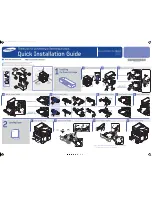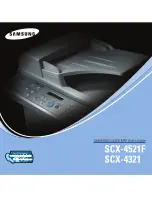
User's Guide
Control Panel 4-37
Specify Handshaking Method
HNDSHK lets you tell the printer what handshaking method your com-
puter is using. Handshaking is a technique that starts and stops data
transmission between your computer and the printer. This starting and
stopping is important so that neither device receives more data than it can
handle at any given time. Without handshaking, the printer's input buffer
could overflow.
The printer supports three handshake protocols: DTR, X-ON/X-OFF and
ENQ/ACK. DTR is a hardware handshake that uses the Data Terminal
Ready line in the serial interface. Both X-ON/X-OFF and ENQ/ACK
are software handshakes that require the computer or printer to send
certain data bytes on its data transmission line. You can specify
DTR
for
the DTR hardware method;
XON
for the X-ON/X-OFF software
method;
ENQ
for the ENQ/ACK software method;
D/X
for both the
DTR and X-ON/X-OFF methods;
D/E
for both the DTR and ENQ/
ACK methods; or
None
for no handshaking method. Both your computer
and the printer must use the
same
handshaking method(s).
Specify Number of Data Bits
DATA BITS lets you tell the printer how many data bits your computer is
sending in each byte. You must select
7
if your computer sends 7-bit
bytes; or
8
if your computer sends 8-bit bytes.
Specify Number of Stop Bits
STOP BITS lets you tell the printer how many stop bits your computer is
sending in each byte. Stop bits are necessary to separate consecutive
bytes in the data stream. You must select
1
if your computer sends one
stop bit; or
2
if your computer sends two stop bits.
45) HNDSHK: D/X
46) DATA BITS: 8
47) STOP BITS: 1
User's Guide
Control Panel 4-37
Specify Handshaking Method
HNDSHK lets you tell the printer what handshaking method your com-
puter is using. Handshaking is a technique that starts and stops data
transmission between your computer and the printer. This starting and
stopping is important so that neither device receives more data than it can
handle at any given time. Without handshaking, the printer's input buffer
could overflow.
The printer supports three handshake protocols: DTR, X-ON/X-OFF and
ENQ/ACK. DTR is a hardware handshake that uses the Data Terminal
Ready line in the serial interface. Both X-ON/X-OFF and ENQ/ACK
are software handshakes that require the computer or printer to send
certain data bytes on its data transmission line. You can specify
DTR
for
the DTR hardware method;
XON
for the X-ON/X-OFF software
method;
ENQ
for the ENQ/ACK software method;
D/X
for both the
DTR and X-ON/X-OFF methods;
D/E
for both the DTR and ENQ/
ACK methods; or
None
for no handshaking method. Both your computer
and the printer must use the
same
handshaking method(s).
Specify Number of Data Bits
DATA BITS lets you tell the printer how many data bits your computer is
sending in each byte. You must select
7
if your computer sends 7-bit
bytes; or
8
if your computer sends 8-bit bytes.
Specify Number of Stop Bits
STOP BITS lets you tell the printer how many stop bits your computer is
sending in each byte. Stop bits are necessary to separate consecutive
bytes in the data stream. You must select
1
if your computer sends one
stop bit; or
2
if your computer sends two stop bits.
45) HNDSHK: D/X
46) DATA BITS: 8
47) STOP BITS: 1
Содержание AMT ACCEL-5350
Страница 1: ...Document No 397000 B User s Guide AMTACCEL 5350 ...
Страница 2: ......
Страница 4: ...User s Guide ii Preface ...
Страница 22: ...User s Guide xx Contents ...
Страница 26: ......
Страница 44: ...User s Guide 2 14 Set Up ...
Страница 62: ...User s Guide 3 18 Loading Paper ...
Страница 106: ...User s Guide 4 44 Control Panel ...
Страница 158: ......
Страница 164: ...User sGuide B 6 Bar Codes ...
Страница 178: ......
Страница 242: ......
Страница 254: ......
Страница 255: ...AMT Datasouth Corp 4765 Calle Quetzal Camarillo CA 93012 8546 www amtdatasouth com ...
















































